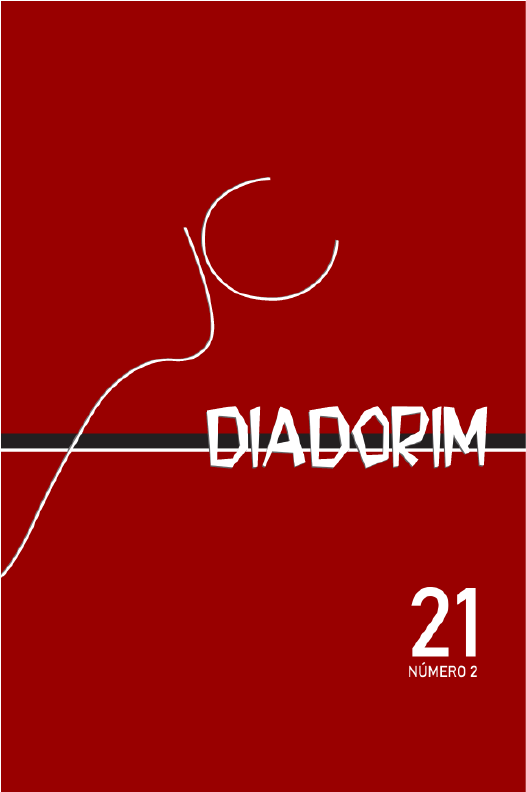LINGUISTIC VARIATION AND CHANGE
DOI:
https://doi.org/10.35520/diadorim.2019.v21n2a31055Keywords:
Construction Grammar, Variation, ChangeReferences
AUER, P.; MURRAY, R.W. (orgs.). Hermann Paul’s ‘Principles of Language History’ Revisited: Translations and Reflections. Berlin/Boston: de Gruyter, 2015.
BRAGA, M. L. Construções clivadas no português do Brasil sob uma abordagem funcionalista. Matraga. V.16, p. 173-196, 2009.
BRAGA, M. L.; LEITE DE OLIVEIRA, D. BARBOSA, E. M. Gradiência e variação nas construções de foco no português brasileiro. Cadernos de Letras da UFF - Dossiê: Língua em uso 47, p. 29-43, 2013.
BOOIJ, G. Construction Morphology. Oxford: Oxford University Press, 2010.
BOOIJ, G. Inheritance and motivation in Construction Morphology. In GISBORNE, N.; HIPPISLEY, A. (ed). Defaults in morphological theory. Oxford: Oxford University Press, 2017, p. 18-39.
BYBEE, J. Language, usage and cognition. Cambridge: University Press, 2010.
BYBEE, J. Língua, uso e cognição. Trad. Maria Angélica Furtado da Cunha. Rev. téc. Sebastião Carlos Leite Gonçalves. São Paulo: Cortez, 2016.
CAPPELLE, B. Particle placement and the case for ‘allostructions’. In SCHÖNEFELD, D. (ed.) Constructions All Over: Case Studies and Theoretical Implications, Special volume of Constructions SV1-7/2006, 2006.
CAPPELLE, B. Can we factor out free choice? In: DUFTER, A.; FLEISCHER, J.; SEILER,G. (eds.) Describing and Modeling Variation in Grammar. Berlin/New York: Mouton de Gruyter, 2009, p. 183-199.
DIEWALD, G. A model of relevant types of contexts in grammaticalization. In: WISCHER, I; DIEWALD, G (eds). New reflections on grammaticalization. Amsterdam/Philadelphia: John Benjamins, 2002, p. 103-120.
DIEWALD, G. Context types in grammaticalization as constructions. Constructions, Düsseldorf. Disponível em: www.constructions-online.de:0009- 4-6860, 2006.
DIEWALD, G; SMIRNOVA, E. “Paradigmatic integration”: the fourth stage in an expanded grammaticalization scenario. In: DAVIDSE, K. at al (eds). Grammaticalization and language change – new reflections. Amsterdam/Philadelphia: John Benjamins, 2012, p. 111-131.
GOLDBERG, A. Constructions: a construction approach to argument structure. Chicago: The University of Chicago Press, 1995.
GOLDBERG, A. Constructions at work: the nature of generalization in language. Oxford: Oxford University Press, 2006.
GOLDBERG, A. E. Constructions and Variation. Revision for News Ways of Analyzing Variation. S. A. Grondelaers (ed.), a sair. 22 fl.
GONÇALVES, C. A. V. Morfologia Construcional: uma introdução. São Paulo: Contexto, 2016.
GRIES, S.; Stefanowitsch, A. Extending collostructional analysis. A corpus-based perspective on ‘alternations’. International Journal of Corpus Linguistics 9:1, 2004, p. 97-129.
HOFFMAN, T.; TROUSDALE, G. Variation, change and constructions in English. Cognitive Linguistics, 22, 1-23, 2011.
MACHADO VIEIRA, M. S. Variação e mudança na descrição construcional: complexos verbo-nominais. Revista LinguíStica Volume Especial, p. 152-170, 2016.
MACHADO VIEIRA, M. S. Expressões impessoais no discurso acadêmico brasileiro. In.: Revista Digital do Programa de Pós-Graduação em Letras da PUCRS, 2017, p. 82-95.
NEVALAINEN, T.; PALANDER-COLLIN, M. Grammaticalization and sociolinguistics. In: NARROG, H.; HEINE, B. (eds.). The Oxford handbook of grammaticalization. Oxford: Oxford University Press, 2012. p. 1-8, Online.
PEREK, F. Argument Structure in Usage-Based Construction Grammar. Experimental and corpus-based perspectives. Amsterdam: John Benjamins, 2015.
PIERREHUMBERT, J. Exemplar dynamics: Word frequency, lenition and contrast. In: BYBEE, J.; HOPPER, P. (eds.), Frequency and the emergence of linguistic structure. Amsterdam: John Benjamins, 2001, p. 137-158.
POPLACK, S. Grammaticalization and linguistic variation. In: HEYNE, B.; NARROG, H. Handbook of grammaticalization. Oxford: Oxford University Press, 2012. p. 209-224.
SOLEDADE, J. Por uma abordagem cognitiva da morfologia: revisando a morfologia construcional. In: ALMEIDA, A. A. D.; SANTANA, E. S. (orgs.). Linguística Cognitiva: redes de conhecimento d'aquém e d'além mar Salvador: Edufba, 2018, p. 345-378.
TORRENT, T. T. Usage-based models in linguistics: an interview with Joan Bybee. Revista LinguíStica / Revista do Programa de Pós-Graduação em Linguística da Universidade Federal do Rio de Janeiro. Volume 8, número 1, junho de 2012. ISSN1808-835X 1. [http://www.letras.ufrj.br/poslinguistica/ revistalinguistica.
TRAUGOTT, E.; TROUSDALE, G. Constructionalization and constructional changes. Oxford: Oxford University Press, 2013.
VAN DE VELDE, F. Degeneracy: the maintenance of constructional networks. In: BOOGAART, R; COLLEMAN, T; RUTTEN, G. (eds). Constructions all the way everywhere: the extending scope of construction grammar. Berlin: Mouton de Gruyter, 2014, p. 141-179.
VIEIRA, A. F. C; LEITE DE OLIVEIRA; D. HORA, K. F. P. N. A.; OLIVEIRA, S. S.; MASSON, S. P. Complexidade Cognitiva em Construções de Foco do PB – um experimento de priming. ReVEL, edição especial n. 10, p.265-281, 2015.
WIEDEMER, M. L; MACHADO VIEIRA, M. S. Sociolinguística e Gramática de Construções: o envelope da variação. In: FRANCESCHINI, L. T.; LOREGIAN-PENKAL, L. (orgs.). Sociolinguística: estudos de variação, mudança e atitudes linguísticas, 2018, p. 41-77.
Downloads
Published
Issue
Section
License
Copyright transfer -- Authorization to publication
If the submitted article is approved for publication, it is already agreed that the author authorizes UFRJ to reproduce it and publish it in Diadorim: revista de estudos linguísticos e literários, the terms "reproduction" and "publication" being understood as defined respectively by items VI and I of article 5 of Law 9610/98. The article can be accessed both by the World Wide Web (WWW) and by the printed version, with free consultation and reproduction of a copy of the article for the own use of those who consult. This authorization of publication is not limited in time, and UFRJ is responsible for maintaining the identification of the author of the article.

The journal Diadorim: revista de estudos linguísticos e literários is licensed under a Creative Commons Attribuition-NonCommercial 4.0 International (CC BY-NC 4.0).

